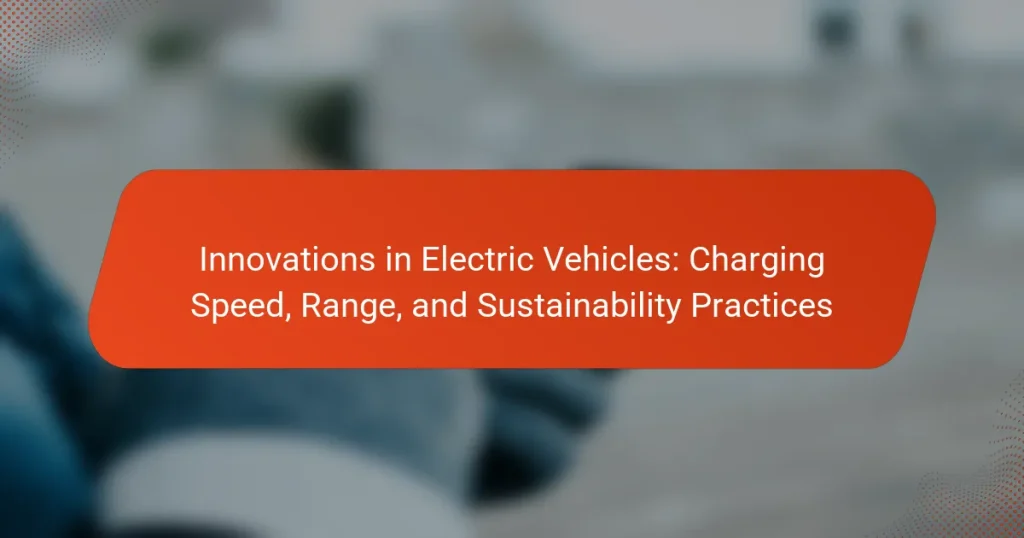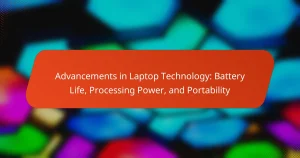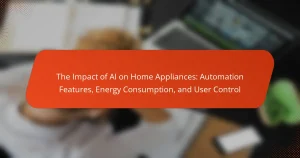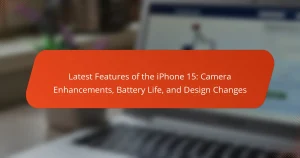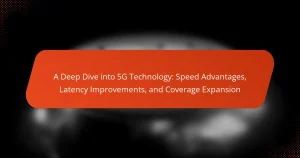Electric vehicles (EVs) are experiencing significant innovations that enhance their performance, charging speed, and sustainability practices. Key advancements include improved lithium-ion and emerging solid-state battery technologies, which increase energy density and extend driving ranges. The expansion of ultra-fast charging infrastructure allows for rapid recharging, reducing downtime for users and facilitating long-distance travel. Additionally, vehicle-to-grid technology and advancements in lightweight materials promote energy efficiency and sustainability. These developments collectively support the growing adoption of electric vehicles in the market, with a focus on user satisfaction and environmental responsibility.
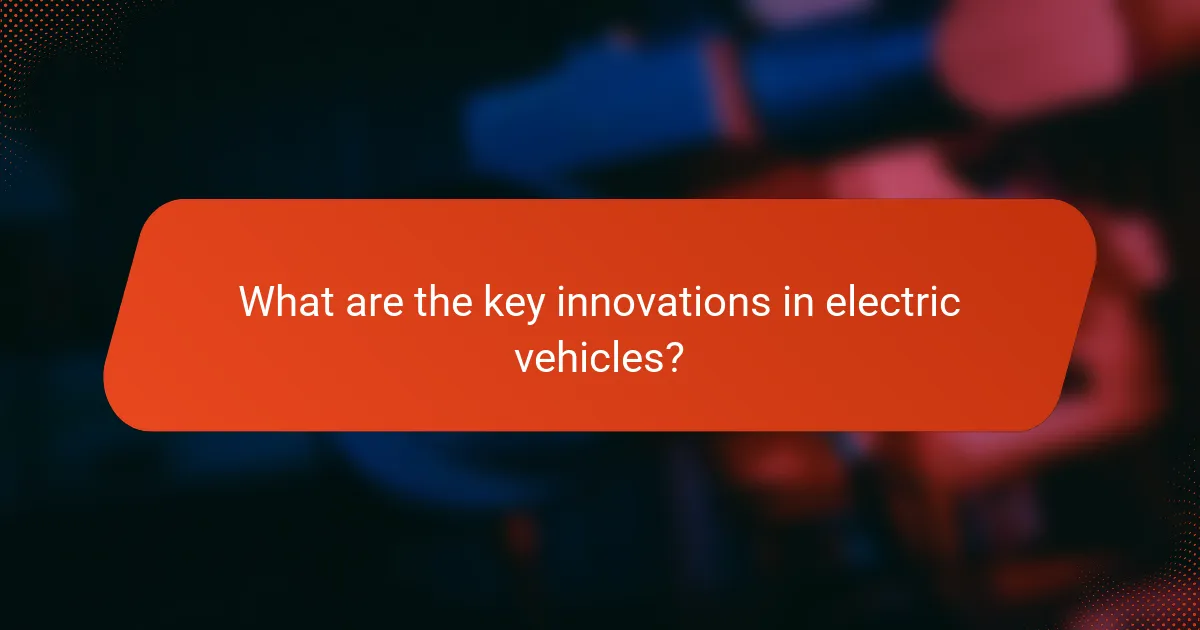
What are the key innovations in electric vehicles?
Key innovations in electric vehicles include advancements in battery technology, charging infrastructure, and energy efficiency. Improved lithium-ion batteries now offer higher energy density, resulting in longer ranges. Fast-charging stations significantly reduce charging time, enabling drivers to recharge in under 30 minutes. Regenerative braking systems enhance energy recovery during driving, increasing overall efficiency. Vehicle-to-grid technology allows electric vehicles to return power to the grid, promoting energy sustainability. Innovations in lightweight materials reduce vehicle weight, improving performance and range. Enhanced software integration provides better vehicle management and user experience. These innovations collectively contribute to the growth and adoption of electric vehicles in the market.
How has charging speed evolved in electric vehicles?
Charging speed in electric vehicles has significantly improved over the years. Initially, standard charging options offered around 3 to 5 kW. This allowed for slow charging, taking several hours to fully charge a vehicle. As technology advanced, Level 2 chargers emerged, providing up to 22 kW. This reduced charging time to a few hours, making it more convenient for users.
The introduction of DC fast charging has further accelerated this evolution. These chargers can deliver between 50 kW to 350 kW. With this capability, electric vehicles can achieve an 80% charge in as little as 30 minutes.
Recent developments include ultra-fast charging stations, which are being deployed globally. These stations can support charging speeds exceeding 350 kW, significantly reducing downtime for electric vehicle users.
Furthermore, battery technology has improved, allowing for higher charging rates without damaging battery life. For example, Tesla’s Supercharger V3 can charge up to 250 kW, enhancing the overall driving experience.
Overall, the evolution of charging speed has made electric vehicles more practical and user-friendly.
What technologies are driving improvements in charging speed?
Fast charging technologies are driving improvements in charging speed. These technologies include DC fast charging, which delivers high power directly to the vehicle’s battery. Another key technology is wireless charging, which allows for charging without physical connectors. Additionally, advancements in battery chemistry, such as lithium-ion and solid-state batteries, enhance charging efficiency. Ultra-fast charging stations can provide up to 350 kW of power, significantly reducing charging time. Research indicates that these innovations can cut charging times to under 30 minutes for a full charge. Improved thermal management systems also play a role by maintaining optimal battery temperatures during charging. Collectively, these technologies are transforming the electric vehicle landscape by making charging faster and more convenient.
How do different charging stations impact charging speed?
Different charging stations significantly impact charging speed. Charging stations vary in power output, which directly affects how quickly an electric vehicle charges. Level 1 chargers provide 120 volts and typically deliver 2 to 5 miles of range per hour. Level 2 chargers, offering 240 volts, can provide 10 to 60 miles of range per hour. DC fast chargers, on the other hand, deliver 400 volts or more, enabling vehicles to gain 60 to 100 miles of range in just 20 minutes.
The charging speed also depends on the vehicle’s battery capacity and its acceptance rate. For example, a vehicle that can accept higher power will charge faster at a compatible station. According to the U.S. Department of Energy, using a DC fast charger can reduce charging time by up to 80% compared to Level 1 chargers. Thus, the type of charging station plays a crucial role in determining how quickly an electric vehicle can recharge.
What is the significance of range in electric vehicles?
Range in electric vehicles (EVs) is crucial for their usability and consumer acceptance. A longer range allows drivers to travel greater distances on a single charge. This reduces the need for frequent recharging, enhancing convenience. Range impacts the overall driving experience, especially for long trips.
Statistically, vehicles with a range of over 300 miles are more appealing to consumers. According to a 2022 study by the International Council on Clean Transportation, EVs with extended ranges see higher adoption rates. Range anxiety, the fear of running out of battery, is a significant barrier to EV adoption.
Improving range can mitigate this concern. Manufacturers are investing in battery technology to increase energy density. This innovation directly correlates with the significance of range in promoting electric vehicle usage.
How is the range of electric vehicles measured?
The range of electric vehicles is measured using standardized testing procedures. These procedures assess how far a vehicle can travel on a single charge. The most common standard used is the EPA (Environmental Protection Agency) test cycle in the United States. This cycle simulates real-world driving conditions, including acceleration, braking, and speed variations.
Additionally, manufacturers may also use the WLTP (Worldwide Harmonized Light Vehicles Test Procedure) in Europe. This test provides a more comprehensive assessment of range under various conditions. The final range figure is often displayed on the vehicle’s specifications.
Real-world factors, such as driving habits, terrain, and temperature, can affect actual range. Manufacturers often provide an estimated range based on ideal conditions. This helps consumers understand the potential performance of the vehicle.
What factors influence the range of electric vehicles?
The range of electric vehicles is influenced by several factors. Battery capacity is a primary determinant, measured in kilowatt-hours (kWh). Larger batteries store more energy, enabling longer distances. Vehicle weight also affects range; heavier vehicles require more energy to operate. Aerodynamics play a role as well; streamlined designs reduce drag and improve efficiency. Driving habits significantly impact range; aggressive acceleration and high speeds consume more energy. Environmental conditions, such as temperature, can affect battery performance and efficiency. Lastly, tire pressure and type influence rolling resistance, which can further impact the overall range of electric vehicles.
Why are sustainability practices important in electric vehicle development?
Sustainability practices are crucial in electric vehicle development because they minimize environmental impact. These practices help reduce carbon emissions during production and operation. For example, using renewable energy sources in manufacturing can cut emissions significantly. Additionally, sustainable materials can improve recyclability and reduce resource depletion. Implementing sustainable practices can enhance consumer trust and marketability. According to a report by the International Energy Agency, electric vehicles can reduce greenhouse gas emissions by up to 70% compared to conventional vehicles. Thus, sustainability practices are essential for creating a cleaner and more efficient transportation future.
How do electric vehicles contribute to environmental sustainability?
Electric vehicles (EVs) contribute to environmental sustainability by reducing greenhouse gas emissions. Unlike traditional gasoline vehicles, EVs produce zero tailpipe emissions. This significantly lowers air pollution in urban areas. According to the U.S. Department of Energy, EVs can reduce carbon dioxide emissions by up to 50% compared to conventional vehicles. Additionally, EVs are often powered by renewable energy sources, further decreasing their environmental impact. The use of regenerative braking in EVs enhances energy efficiency. This technology recaptures energy during braking, which can be reused. Overall, EVs play a crucial role in promoting cleaner air and reducing reliance on fossil fuels.
What are the best sustainability practices in the electric vehicle industry?
The best sustainability practices in the electric vehicle industry include the use of renewable energy sources for charging. This reduces carbon emissions associated with electricity generation. Implementing battery recycling programs is another key practice. Recycling batteries decreases the demand for raw materials and minimizes waste. Additionally, manufacturers are focusing on sustainable materials in vehicle production. This includes using recycled plastics and lightweight materials to enhance efficiency.
Another practice is the development of energy-efficient manufacturing processes. These processes lower the overall environmental impact of vehicle production. Furthermore, promoting vehicle lifespan through maintenance and repair initiatives supports sustainability. This extends the life of electric vehicles and reduces the need for new production.
Lastly, companies are investing in infrastructure for electric vehicle charging. Expanding charging networks encourages the use of electric vehicles, thereby reducing reliance on fossil fuels. These practices collectively contribute to a more sustainable electric vehicle industry.

How do innovations in charging speed affect user experience?
Innovations in charging speed significantly enhance user experience by reducing downtime. Faster charging allows electric vehicle users to spend less time waiting at charging stations. For instance, ultra-fast chargers can deliver up to 350 kW, enabling a 100-mile range in just 10 minutes. This convenience mirrors traditional refueling times for gasoline vehicles. Additionally, improved charging speed increases the practicality of electric vehicles for long-distance travel. Users experience less range anxiety when charging options are quick and accessible. According to a study by the International Council on Clean Transportation, faster charging infrastructure leads to higher adoption rates of electric vehicles. Overall, advancements in charging speed directly correlate with increased user satisfaction and wider electric vehicle acceptance.
What challenges do consumers face with charging speed?
Consumers face several challenges with charging speed in electric vehicles. One major challenge is the variability in charging infrastructure. Not all charging stations provide the same level of power output. This inconsistency can lead to longer wait times for consumers.
Another challenge is the charging speed of home chargers. Many consumers use standard outlets that deliver slower charging rates. This can result in insufficient overnight charging for daily use.
Additionally, battery technology limits charging speed. Fast charging can generate heat, which may affect battery lifespan. Some consumers may avoid fast charging to preserve battery health.
Lastly, the availability of fast chargers is limited in some regions. This can restrict long-distance travel options for consumers. Overall, these factors contribute to the challenges consumers face with charging speed.
How do charging times compare to traditional fuel refilling?
Charging times for electric vehicles are generally longer than traditional fuel refilling. Refueling a gasoline vehicle typically takes about 5 minutes. In contrast, charging an electric vehicle can take anywhere from 30 minutes to several hours, depending on the charger type. Fast chargers can reduce charging time to around 30 minutes for an 80% charge. Level 2 chargers, commonly found at home, may take 4 to 8 hours for a full charge. These differences highlight the convenience of traditional refueling compared to current electric vehicle charging times.
What solutions are being implemented to enhance user experience?
Electric vehicle manufacturers are implementing various solutions to enhance user experience. These solutions include faster charging technologies, which reduce charging time significantly. For example, ultra-fast charging stations can provide up to 350 kW, allowing drivers to recharge in under 30 minutes. Additionally, many manufacturers are improving battery range through advanced battery chemistry. Some electric vehicles now offer ranges exceeding 300 miles on a single charge. User-friendly interfaces are also being developed, featuring intuitive navigation and real-time charging station availability. Furthermore, over-the-air software updates enhance vehicle performance and introduce new features without requiring a visit to the dealership. These innovations collectively aim to make electric vehicle ownership more convenient and enjoyable.
How does electric vehicle range impact consumer adoption?
Electric vehicle range significantly impacts consumer adoption. A longer range alleviates range anxiety, which is a common concern among potential buyers. According to a 2021 survey by the International Council on Clean Transportation, 60% of consumers cited range as a major factor in their decision to purchase an electric vehicle. Vehicles with a range of over 300 miles are increasingly preferred, as they provide more flexibility for long trips. Additionally, advancements in battery technology have led to improved ranges in newer models. For instance, the Tesla Model S offers a range of approximately 405 miles, boosting its appeal. Conversely, vehicles with limited range may deter consumers due to fears of running out of charge. Thus, electric vehicle range is a critical factor influencing market acceptance and growth.
What are the common misconceptions about electric vehicle range?
Common misconceptions about electric vehicle range include the belief that all electric vehicles (EVs) have a limited range similar to older models. Many people think that EVs cannot travel long distances without recharging. In reality, many modern EVs offer ranges exceeding 250 miles on a single charge. Another misconception is that driving habits significantly decrease range. While aggressive driving can impact efficiency, maintaining a steady speed can optimize range. Additionally, some believe that cold weather drastically reduces range. While temperature affects battery performance, advancements in battery technology have mitigated this issue. Furthermore, there is a notion that charging infrastructure is inadequate. However, the number of charging stations has been rapidly increasing, making long trips more feasible. Lastly, many assume that charging an EV takes a long time. Fast chargers can replenish significant battery capacity in under an hour, enhancing convenience for users.
How are manufacturers addressing range anxiety among consumers?
Manufacturers are addressing range anxiety among consumers by enhancing battery technology and expanding charging infrastructure. Improved battery capacity allows electric vehicles (EVs) to travel longer distances on a single charge. For example, some EV models now offer ranges exceeding 300 miles. Additionally, manufacturers are investing in fast-charging stations. These stations can recharge a vehicle’s battery to 80% in about 30 minutes. Partnerships with charging networks further increase accessibility for consumers. Some companies also provide real-time range estimates through smartphone apps. This helps drivers plan their journeys more effectively. Overall, these strategies aim to build consumer confidence in EVs.
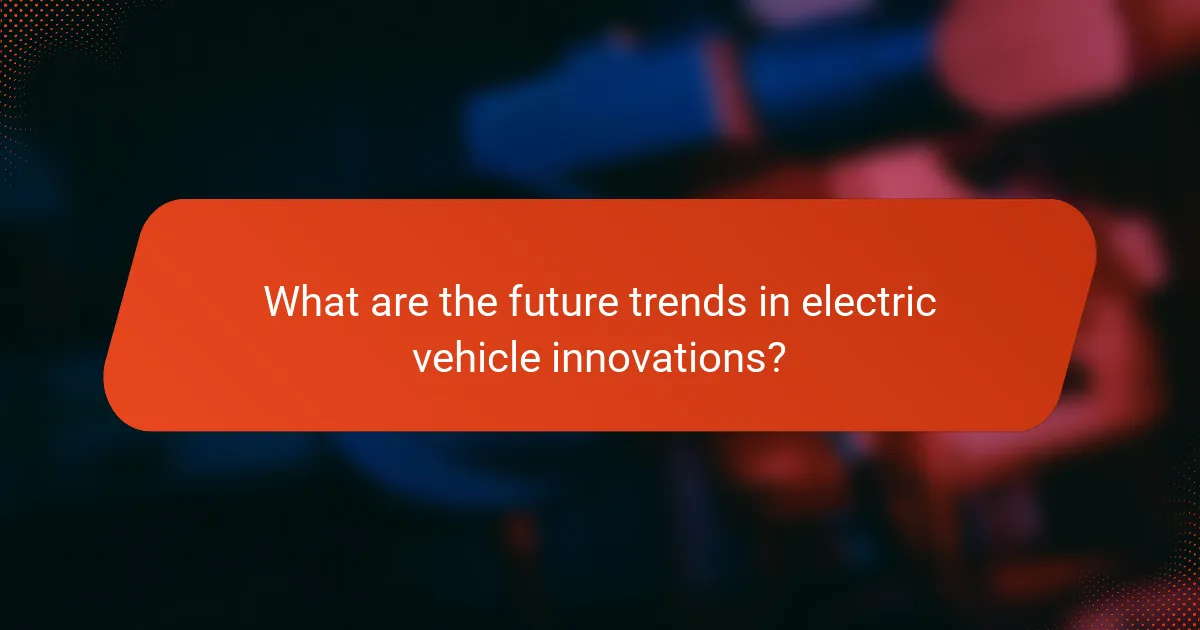
What are the future trends in electric vehicle innovations?
Future trends in electric vehicle innovations include advancements in battery technology, enhanced charging infrastructure, and increased vehicle automation. Battery technology is evolving towards solid-state batteries. These batteries promise higher energy density and faster charging times. Research indicates solid-state batteries could double the range of current lithium-ion batteries. Charging infrastructure is expanding with ultra-fast charging stations. These stations can charge vehicles in under 30 minutes. Furthermore, wireless charging technology is being developed for convenience. Automation in electric vehicles is also progressing. Features like autonomous driving and smart navigation are becoming standard. Sustainable practices are gaining traction, with manufacturers focusing on recycling battery materials. Innovations in vehicle-to-grid technology allow EVs to contribute to energy supply. Overall, these trends aim to enhance performance, convenience, and sustainability in electric vehicles.
How will advancements in battery technology shape the future?
Advancements in battery technology will significantly shape the future of electric vehicles (EVs). Improved battery efficiency will lead to longer driving ranges for EVs. For instance, solid-state batteries can potentially increase energy density, providing over 300 miles per charge. Faster charging solutions will reduce downtime, making EVs more convenient for users. Current fast-charging technologies can deliver up to 80% charge in 30 minutes. These advancements will also lower costs, making EVs more accessible. Research indicates that battery costs have dropped by 89% since 2010. Enhanced sustainability practices will emerge, as new technologies focus on recycling and reducing raw material usage. For example, advancements in lithium-ion battery recycling can recover up to 95% of materials. Overall, these developments will drive wider adoption of EVs and contribute to a greener future.
What new materials are being explored for batteries?
New materials being explored for batteries include solid-state electrolytes, lithium-sulfur, and sodium-ion compounds. Solid-state electrolytes enhance safety and energy density compared to traditional liquid electrolytes. Lithium-sulfur batteries offer a higher theoretical capacity than lithium-ion, potentially increasing energy storage. Sodium-ion batteries utilize abundant sodium resources, making them cost-effective and sustainable. Research indicates that these materials can significantly improve battery performance and lifespan. For instance, a study published in Nature Energy highlights the advantages of lithium-sulfur technology in energy density.
How will battery recycling impact sustainability in electric vehicles?
Battery recycling will significantly enhance sustainability in electric vehicles. It reduces the demand for raw materials needed for new batteries. This process minimizes environmental degradation associated with mining. Recycling also lowers energy consumption compared to producing new batteries. According to the International Energy Agency, recycling can recover up to 95% of lithium from used batteries. This recovery process decreases greenhouse gas emissions. Improved battery lifecycle management leads to a circular economy in the automotive industry. Ultimately, effective recycling practices contribute to a more sustainable electric vehicle ecosystem.
What role will government regulations play in electric vehicle innovations?
Government regulations will significantly influence electric vehicle innovations. Regulations can set standards for emissions, safety, and performance. These standards encourage manufacturers to innovate in technology and design. For instance, stricter emissions regulations push companies to develop cleaner technologies. Additionally, government incentives can promote research and development in electric vehicle infrastructure. Regulatory frameworks also guide investments in charging networks. Countries with supportive regulations often see faster adoption rates of electric vehicles. For example, the European Union’s Green Deal aims for a substantial reduction in carbon emissions, driving innovation in electric vehicles.
How are regulations influencing charging infrastructure development?
Regulations significantly influence charging infrastructure development by establishing standards and incentives. These regulations ensure safety, interoperability, and accessibility for users. For example, government mandates can require a certain number of charging stations in new developments. This increases the availability of charging options for electric vehicle owners. Additionally, financial incentives, such as tax credits, encourage private investment in charging networks. Studies show that regions with supportive regulations see faster growth in charging infrastructure. According to the International Energy Agency, countries with clear policies have higher electric vehicle adoption rates, which drives further infrastructure development.
What incentives are being offered to promote electric vehicle adoption?
Governments and organizations are offering various incentives to promote electric vehicle (EV) adoption. These incentives include tax credits, rebates, and grants for purchasing EVs. For example, in the United States, federal tax credits can reach up to $7,500 for eligible electric vehicles. Additionally, some states provide their own rebates, which can further reduce the purchase price.
Other incentives include reduced registration fees and exemptions from tolls in certain areas. Charging infrastructure is also being supported through grants for the installation of charging stations. Many utility companies offer special rates for EV owners to encourage off-peak charging. These financial incentives aim to make electric vehicle ownership more affordable and attractive to consumers.
What practical tips can consumers follow to maximize their electric vehicle experience?
To maximize their electric vehicle experience, consumers should adopt several practical tips. Regularly charging the vehicle at home can ensure it is always ready for use. Utilizing public charging stations effectively can help extend the range during longer trips. Understanding charging speeds and selecting fast chargers when available can significantly reduce downtime. Monitoring battery health through the vehicle’s app can help maintain optimal performance. Planning routes that include charging station locations can alleviate range anxiety. Taking advantage of off-peak charging rates can save on electricity costs. Staying informed about software updates can enhance vehicle functionality and efficiency. Engaging in eco-driving practices can improve energy consumption and extend battery life.
The main entity of this article is electric vehicles (EVs), with a focus on innovations in charging speed, range, and sustainability practices. Key advancements include improvements in battery technology, such as higher energy density and faster charging capabilities, which enhance user experience and reduce range anxiety. The article also examines how charging infrastructure has evolved, detailing the impact of different charging stations on charging speed and the significance of range for consumer adoption. Additionally, it highlights the importance of sustainability in EV development, discussing practices that minimize environmental impact and promote cleaner transportation.
